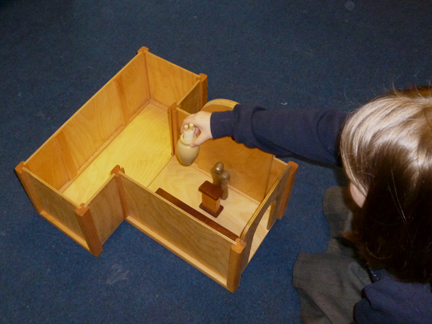Setting up a Godly Play Room Very few churches (if any!) will be in the position of being able to afford to equip an entire Godly Play room instantly from scratch. What follows is based on our experiences of setting up Godly Play in our own churches and other settings. Although in places we suggest some alternatives, we believe it is worth buying the authentic materials when you can afford them. It is also a good idea to attend an introductory training day so as to understand the thinking and ethos behind Godly Play. Stage 1: Trying it out Setting:It is important to set the right atmosphere for Godly Play. If you are setting up in a large space (for example a church hall) you might like to use screens to create a more focused space, or arrange tables in a semi-circle. If you are doing it in a cluttered room, we find it is helpful to throw sheets over the clutter to reduce the "busyness" of the room. Behind the storyteller there should be a focus table with a nativity set, candle, Good Shepherd and sheep. If possible use a plain wooden nativity; the baby needs outstretched arms and to be separate from the manger. If you can, have a poster or figure of the Risen Christ behind the nativity scene.  Stories:We would suggest the Creationcards (which can be made at home) and theParable of the Good Shepherd.The two dimensional figures of the Good Shepherd and sheep can also be made at home, coloured and laminated. The golden parable box can be made from a shoebox and covered in gold paper. Felt for the underlay, water, sheepfold and places of danger can usually be bought locally. Response materials:Paper and card in different colours; pens, pencils, crayons,and felt tips; paints; glue and scissors; playdough or salt dough. Stage 2: Starting outSetting:In an ideal world we would all have a dedicated room, permanently set out with Godly Play materials. The reality is that many of us do Godly Play in places that are used for other things. Some of us may be lucky enough to have cupboard space but for others it is a case of loading crates and boxes and storing everything at home. Between us, we have done Godly Play in dedicated rooms, church, classrooms, staffroom, school and church halls, school library and cloakrooms. Some of these places have no natural lighting and some have no running water... What makes sacred space? In this photograph (courtesy of Storyteller at Wonderful in an Easter kind of way) the furniture has been moved to create a more intimate area. The focus shelf has been aligned with the cross on the wall and the other benches used for the golden parable boxes and the baskets of stories. Orientation can make a difference: I once rotated the setting to face the opposite wall and was amazed at how much calmer and more focused the children became.  Stories:At this stage our first choice would be to add the desert boxand thepeople of God, which enable you to tell many of the stories in Book 1 including The Great Family, Exodus and Exile and Return.The Ten Best Ways to Liveis a desert box story that can be made by buying a heart shaped cardboard box, painting it red and making your own cards.We use under bed storage trays bought from our local DIY store. These have the advantage of being on wheels so can be moved easily. Play sand can be bought from most toy departments and shops and even from supermarkets. We have also experimented with using a sand bag, which is useful if you have nowhere to store a desert box.  We would also include the Flood and the Ark; while the Godly Play set is relatively expensive you may be able to find a set that is suitable for telling the story.The rest of the parables: The Good Samaritan, the Mustard Seed, the Great Pearl, the Sower and the Leavencould now be added. Again, these can be made at home by colouring and laminating the pieces.The Advent cardsare easy to make at home. Frankincense and myrrh can often be bought locally (especailly at Christmas time) for telling the story ofEpiphany. The Baptismset can be put together by using a cheap baby doll and buying jugs and basins from charity shops or bric a brac stalls.The cards for the Circle of the Holy Eucharistcan be made at home and adapted to your own service.Response materials:You might like to add clay and artists pastels to your existing art materials. Coloured pieces of material, shiny paper and sequins are useful for creating collages. Stage 3: Establishing a Godly Play room This was the time when we started buying the authentic Godly Play materials. We would suggest Jerusalem and Bethlehem, the Holy Family, the Liturgical Clock Circle of the Church Year, Jonahand theGood Shepherd and the World Communion.You might also like to replace homemade parable figures with the wooden 2 -dimensional ones. Our Faces on the Wayseries for Lent was painted by a member of the congregation but they can be bought from a Godly Play supplier, as can the series of pictures for the story ofPaul.Response materials:We added wooden blocks of different shapes and sizes at this stage. You might also like to include woodworking tools and different pieces of wood. Stage 4: Developing Godly Play Not all of us have reached this stage! This would be the time to save up for the expensive items: Synagogue and Upper Room, the TabernacleandThe Temple.You might also like to collect the items for the stories of the Old Testament characters and the Prophets from Book 6 and the stories of the Saints from Book 7, many of which can be home made. It is worth remembering that several diocesan resource offices (in the Church of England) and some churches have Godly Play sets available to borrow or share, so you don't have to buy everything yourself. |